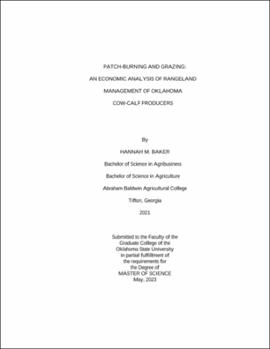| dc.contributor.advisor | Shear, Hannah | |
| dc.contributor.author | Baker, Hannah M. | |
| dc.date.accessioned | 2023-08-25T20:06:09Z | |
| dc.date.available | 2023-08-25T20:06:09Z | |
| dc.date.issued | 2023-05 | |
| dc.identifier.uri | https://hdl.handle.net/11244/338928 | |
| dc.description.abstract | Cattle production involves making complex decisions that influence producer profitability, the environment, and the beef industry. Rangeland management decisions require cattle producers to select practices that improve the sustainability of their rangelands to maintain cattle production while also remaining profitable. The invasion of Eastern red cedar across rangelands due to fire suppression is limiting the number of grazeable acres for cattle, which is the number one use of Oklahoma rangelands. Woody plant encroachment combined with drought impacts becomes expensive for cattle producers who are forced to supplement, destock, or both. The utilization of pyric-herbivory, the interaction between fire and grazing, in the form of patch-burning and grazing is a practice that offers benefits to accomplish the goal of profitable rangeland management. Benefits create improved rangeland productivity by providing high-quality forages, mitigation for drought impacts, and control of woody plant encroachment. | |
| dc.description.abstract | Despite these benefits, adoption of patch-burning and grazing by cattle producers is scarce. The objectives of building an economic analysis of patch-burning and grazing involve raising awareness by providing the costs and long-term economic benefits of implementing patch-burning and grazing and comparing them to the more traditional approach of burning an entire pasture every three years. | |
| dc.description.abstract | Results indicate that patch-burning and grazing will cost approximately $2 more per acre per year than burning the entire pasture every three years. However, the benefit of cows having continual access to high-quality forages in recently burned areas results in a $20/cow/year savings in winter supplementation costs. Patch-burning and grazing also offers mitigation for drought impacts. It is estimated that in a drought year, deciding to skip burning a patch provides an additional five days of grazing for cattle on stockpiled forage in unburned areas. Utilizing patch-burning and grazing before a drought, not burning during a drought year, and resuming after the drought reduces supplementation and burn costs by 2.05 percent and increases the future value of savings by $113/cow compared to traditional management practices after six years. An economic analysis of patch-burning and grazing provides beneficial economic information to aid Oklahoma cow-calf producers in the decision-making process of rangeland management. | |
| dc.format | application/pdf | |
| dc.language | en_US | |
| dc.rights | Copyright is held by the author who has granted the Oklahoma State University Library the non-exclusive right to share this material in its institutional repository. Contact Digital Library Services at lib-dls@okstate.edu or 405-744-9161 for the permission policy on the use, reproduction or distribution of this material. | |
| dc.title | Batch-burning and grazing: An economic analysis of rangeland management of Oklahoma cow-calf producers | |
| dc.contributor.committeeMember | Peel, Derrell | |
| dc.contributor.committeeMember | Raper, Kellie | |
| dc.contributor.committeeMember | Fuhlendorf, Sam | |
| osu.filename | Baker_okstate_0664M_18095.pdf | |
| osu.accesstype | Open Access | |
| dc.type.genre | Thesis | |
| dc.type.material | Text | |
| dc.subject.keywords | cattle production | |
| dc.subject.keywords | cost-benefit analysis | |
| dc.subject.keywords | patch-burn grazing | |
| dc.subject.keywords | pyric-herbivory | |
| dc.subject.keywords | rangeland management | |
| thesis.degree.discipline | Agricultural Economics | |
| thesis.degree.grantor | Oklahoma State University | |
